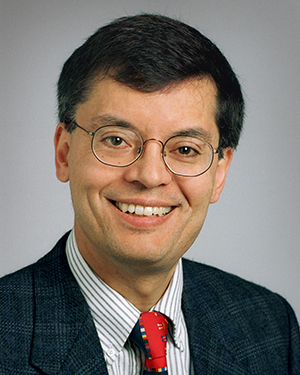Research News
06/16/2025
This research team develops new UV blockers for skin cancer prevention
Unlike other UV blockers, Photosorb is a single, multifunctional ingredient that is safe to use at high concentrations, offering enhanced skin cancer protection in sunscreens.

When it comes to skin cancer prevention, sunscreen is often the first line of defense. As more research emerges about unintended effects sunscreen may have on our bodies and the environment, Cleveland Clinic dermatologist Edward Maytin, MD, PhD, and biomedical engineer Vijay Krishna, PhD, are developing a new active ingredient for sunscreen.
Drs. Krishna and Maytin have determined that their product – Photosorb – holds potential for a safer, more effective option for skin cancer prevention.
How does sunscreen work?
Sunscreen safeguards our skin from damage in two ways:
- Ingredients called UV blockers/absorbers protect us from skin cancer by preventing ultraviolet (UV) light from damaging the DNA in our cells.
- Antioxidants and aspirin-like ingredients shield us from sunburn, preventing the inflammatory response that our skin and immune system generate in response to the DNA damage caused by UV rays.
Sun protection factor (SPF) measures a sunscreen’s combined protective effect against DNA damage and sunburn. Because many UV blocking chemicals are harmful at high concentrations, most sunscreen companies use combinations of ingredients that offer more protection from sunburn than from DNA damage, to achieve a high SPF. The problem with this setup, Dr. Maytin says, is that the immune system activities triggered by sunburn can actually help repair DNA damage and prevent skin cancer.
“Ironically enough, a sunscreen that’s very good at protecting against sunburn might actually cause harm by promoting skin cancer in the long run,” he says.
Improving UV absorbers to avoid outdated ingredients in sunscreen
Based on recent evidence, the FDA has raised concerns about specific UV-blocking ingredients being absorbed into our bloodstream (a list of these ingredients can be found here). A few chemicals, like oxybenzone and avobenzone, are known hormone disruptors in our blood. Many other chemicals on the list have not been tested for safety in our bloodstreams.
“The safest UV blockers are zinc oxide and titanium dioxide. They don’t really get absorbed, and the few particles that do aren't dangerous in our blood,” Dr. Maytin says. “However, even with these UV blockers there is room for improvement. They feel greasier and can leave white streaks on our faces.”
Developing Photosorb as an improved, safer UV absorber
Dr. Krishna and Dr. Maytin teamed up to improve the UV blockers currently available. The team’s goal was to develop a UV blocker that protects our skin from cancer as much as it protects us from burning. Dr. Krishna’s team leads the chemistry and synthesis and Dr. Maytin brings a biological and clinical perspective. Together, they developed and patented Photosorb.
Photosorb is a water-soluble, carbon-based molecule. In 2006, Dr. Krishna showed that a similar type of molecule can absorb UV light and block titanium dioxide photocatalysis, a chemical reaction involving light absorption. Dr Krishna and his team developed Photosorb by modifying the 2006 chemical to enhance its UV light-absorbing properties.

Photosorb's potential for safer, more effective UV blocking
With the help of Cleveland Clinic Innovations and funding from the Case Coulter Translational Research Partnership, the team used an unbiased third party to do efficacy and safety tests for their compound. These tests showed that Photosorb blocks all wavelengths of UV light in a way that is safer and more effective than the current standard.
“Photosorb passed every single safety test,” says Dr. Krishna. “This was very, very exciting because there's no sunscreen on the market that can show safety in all of the tests like ours did at high concentrations.”
Because Photosorb is safe at high levels, Drs. Krishna and Maytin say it can contribute more to sunscreen’s SPF rating than current UV blockers do. The team is currently preparing their sunscreen for the last batch of regulatory tests before commercializing their product.
“I don't think we would have been able to do any of this without both of our expertise, so I’m glad we were able to collaborate and potentially improve skin care and quality of life for people worldwide,” Dr. Maytin says.
Featured Experts
News Category
Related News
Research areas
Want To Support Ground-Breaking Research at Cleveland Clinic?
Discover how you can help Cleveland Clinic save lives and continue to lead the transformation of healthcare.
Give to Cleveland Clinic
